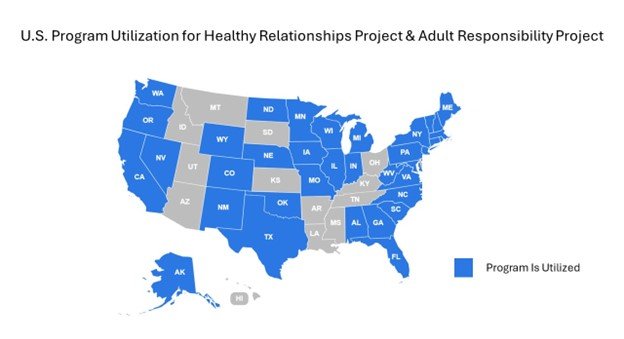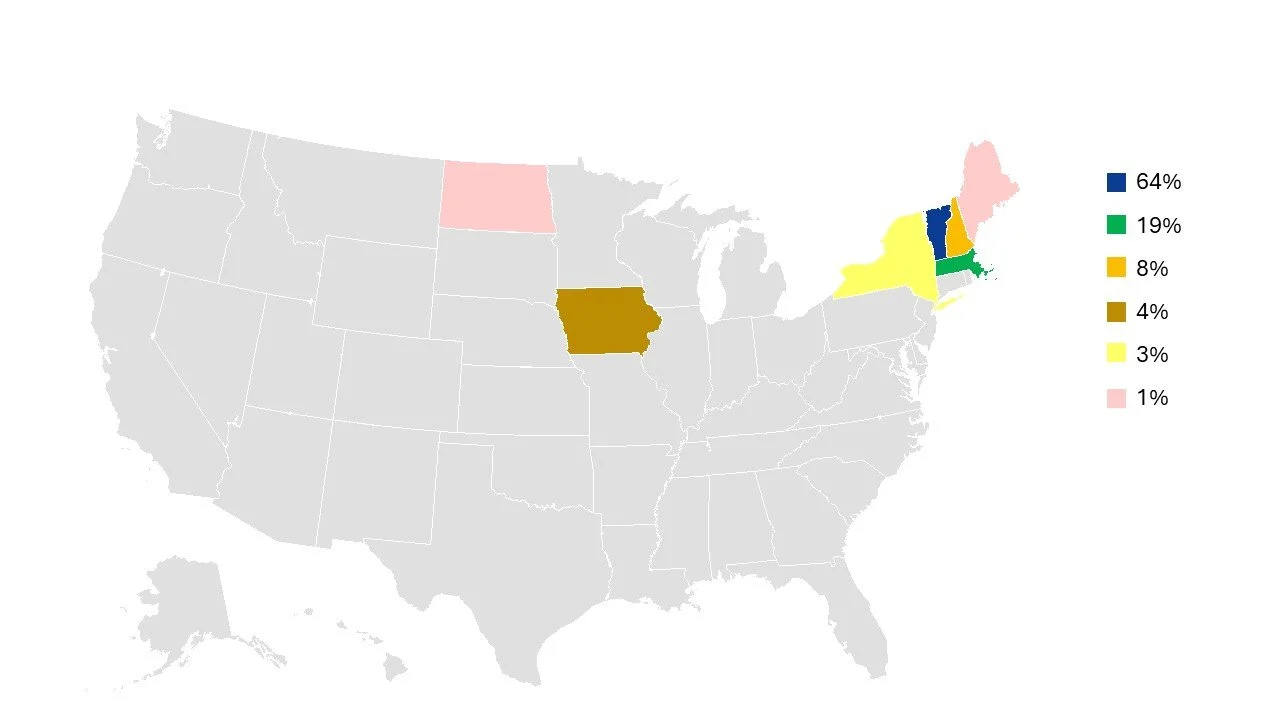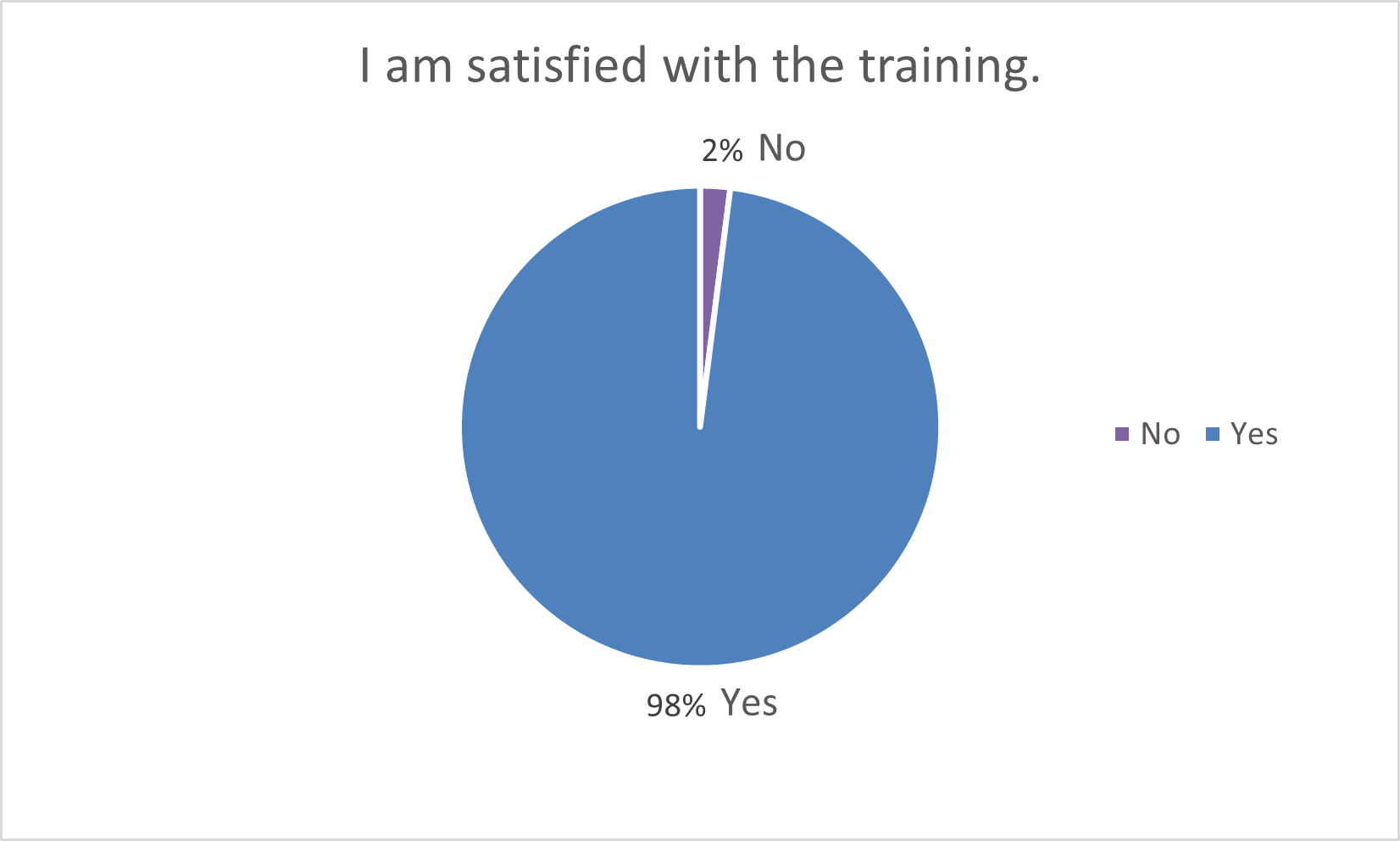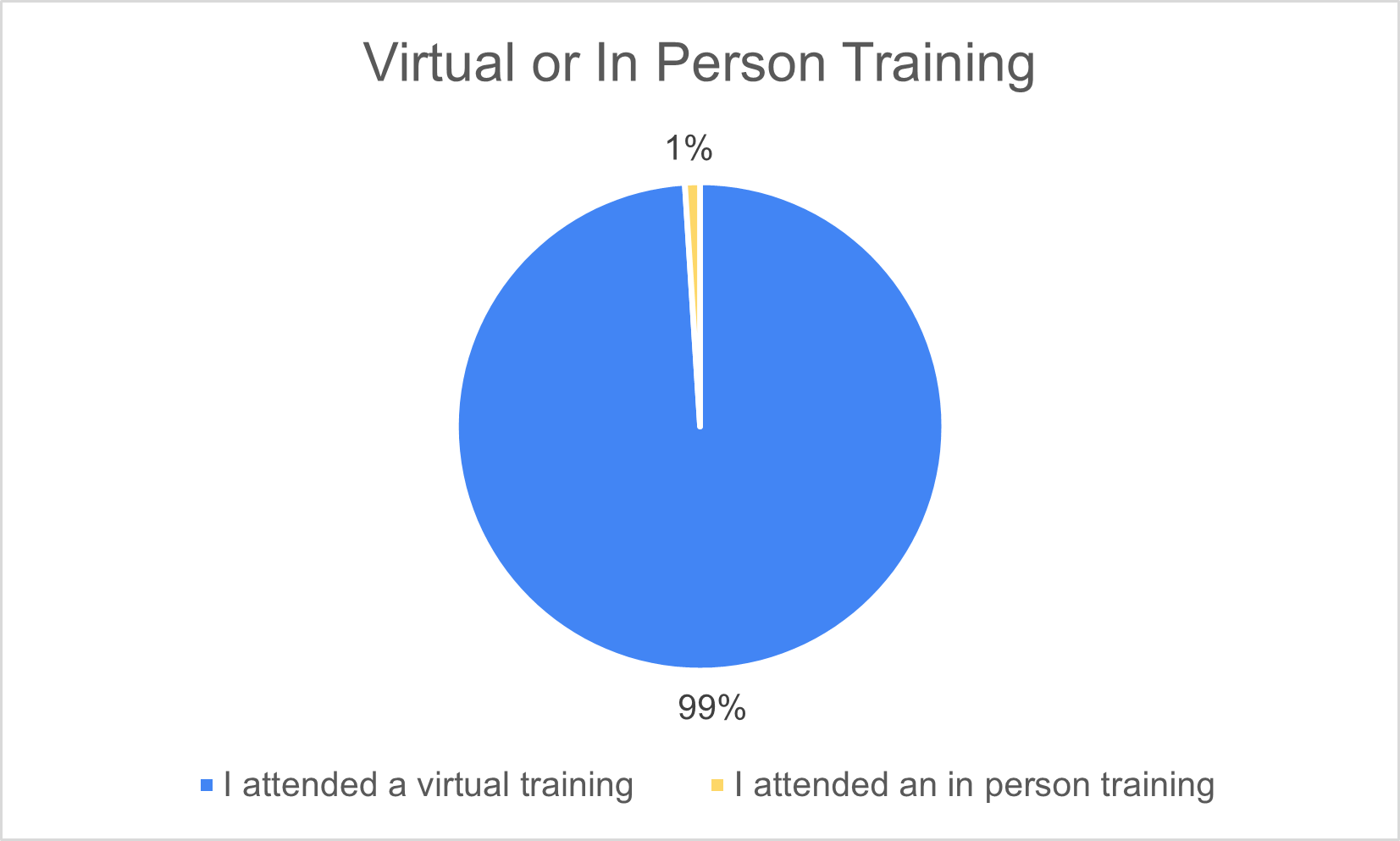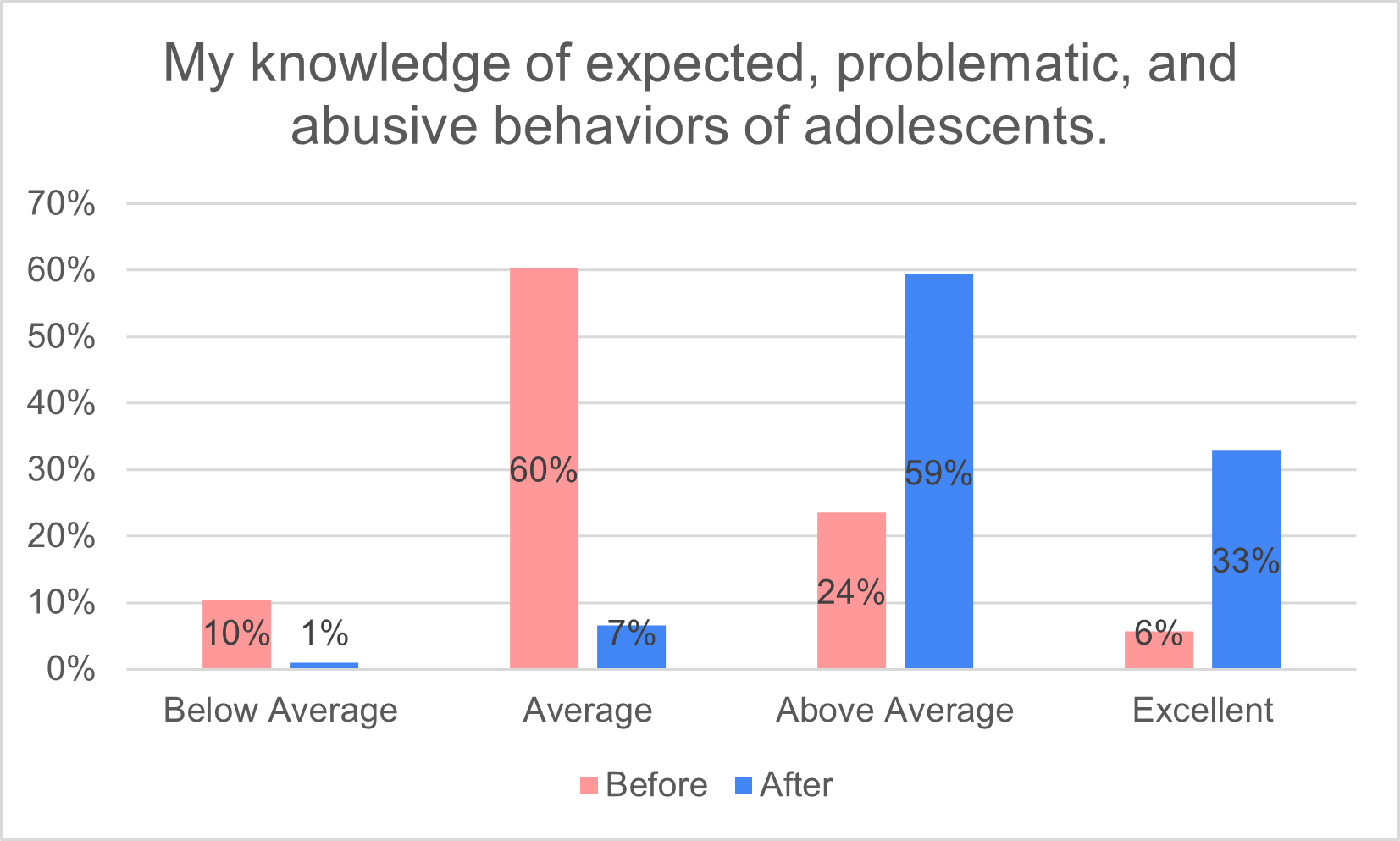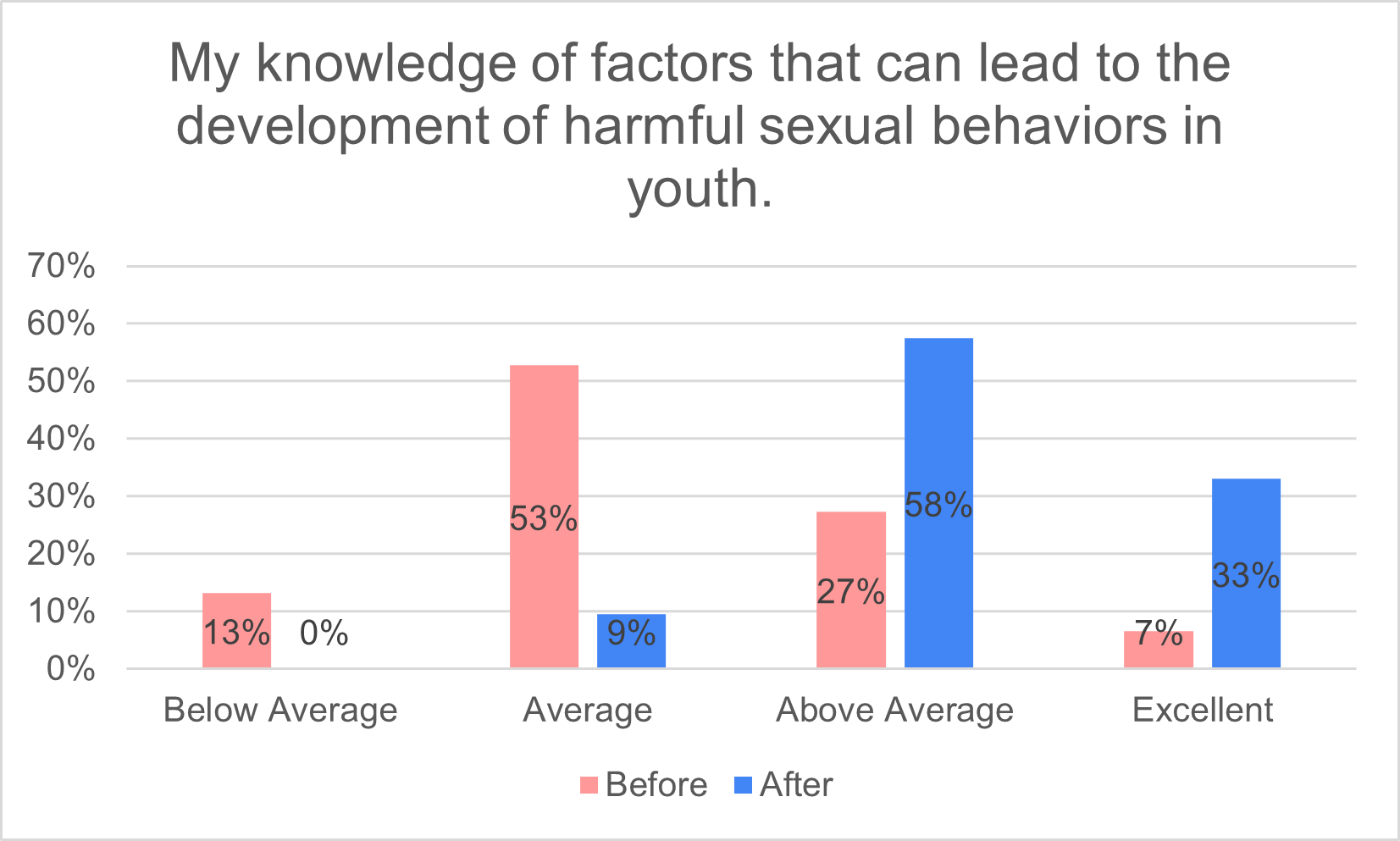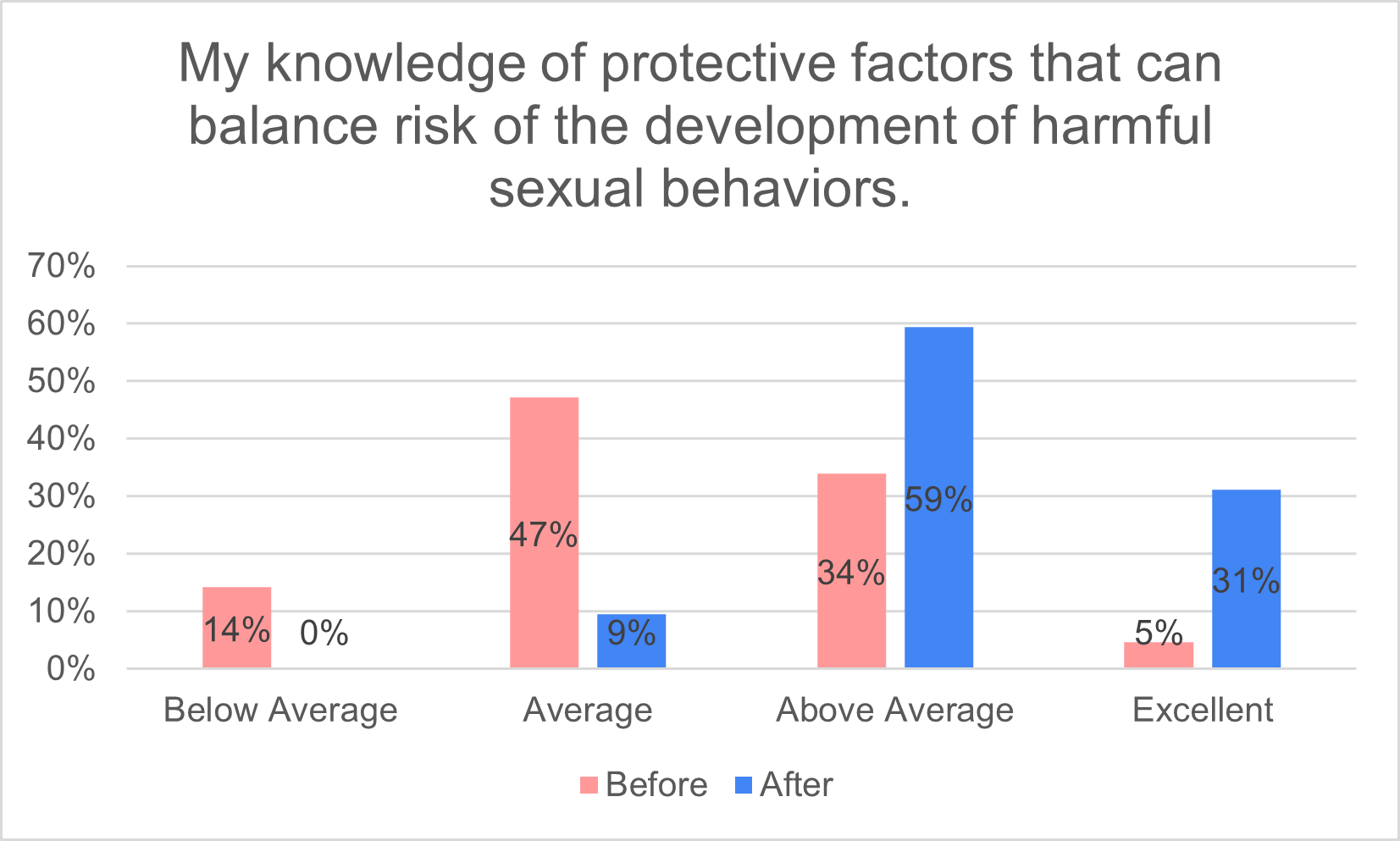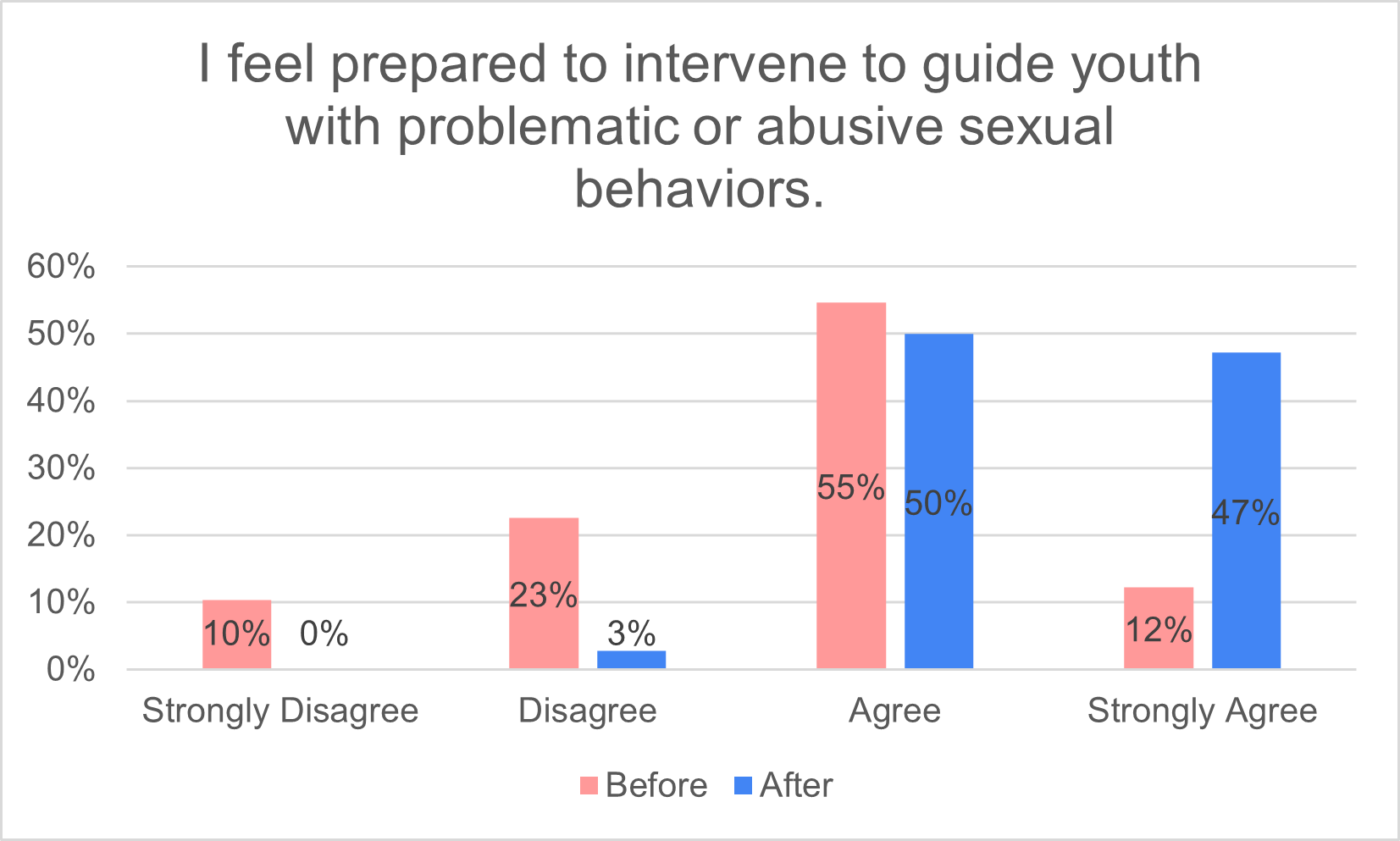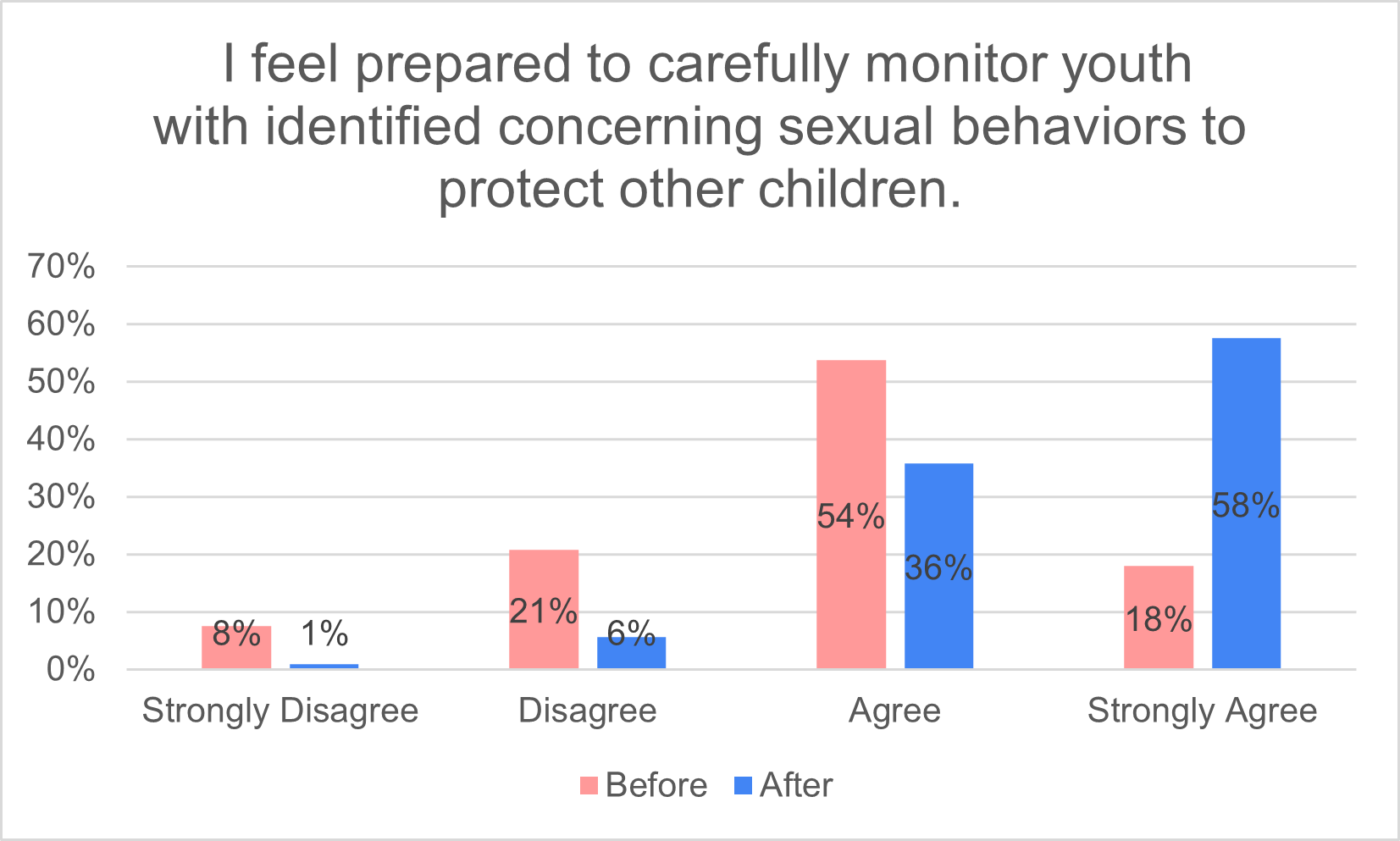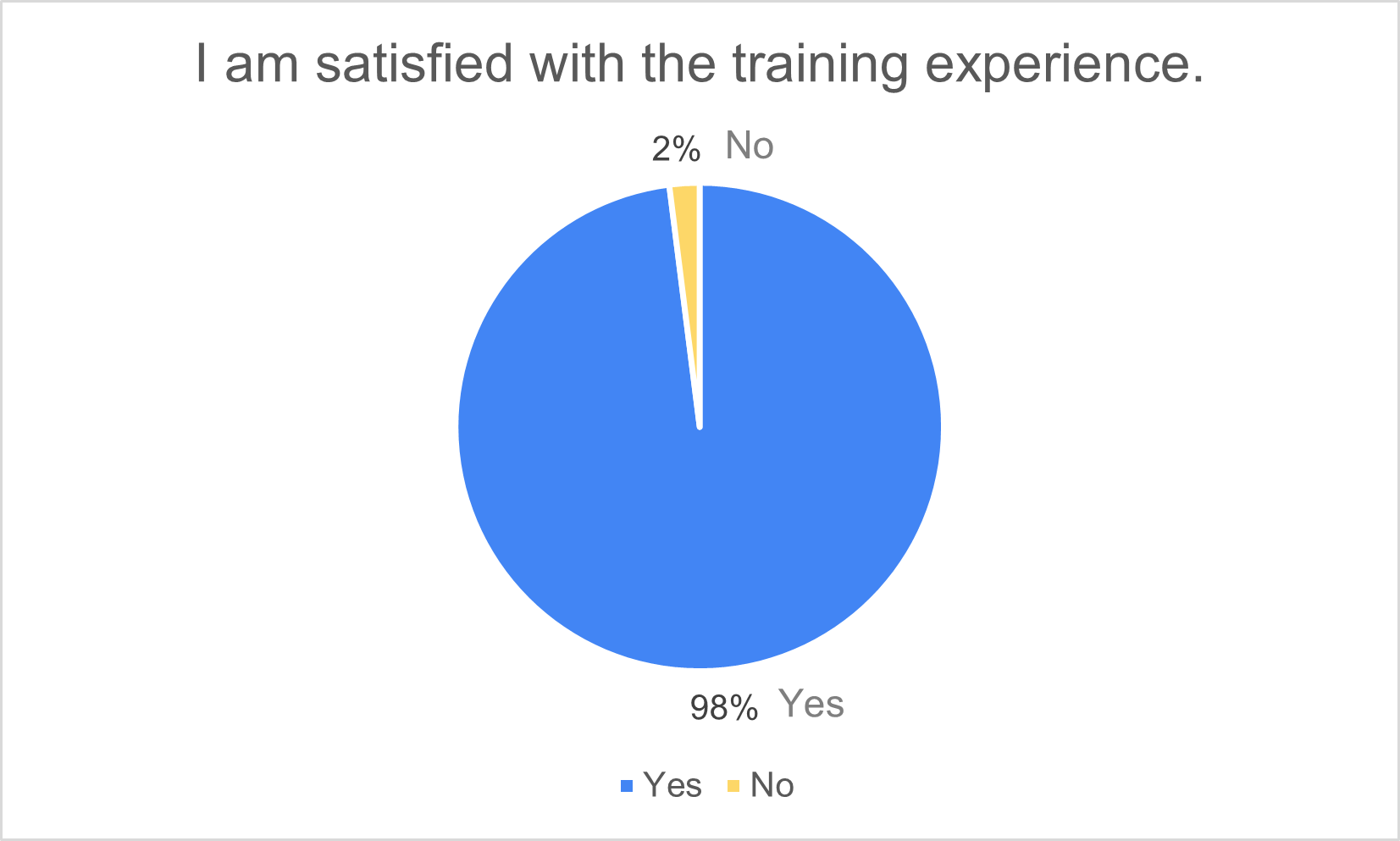The Healthy Relationships Project ®
Adult-focused Programs Empirical Basis and Evaluation Results
Prevent Child Abuse Vermont has developed training for adults on prevention topics called the Adult Responsibility Project, shown in research to be associated with decreases in child sexual abuse. Each training is safety-supporting, raises protective factors that are indicated by research, and engages adult responsibility to protect children. Attendees show better knowledge about child sexual abuse and preventative factors and improved skills to respond to keep children safe from this type of harm. All of our participants have the opportunity to evaluate the training. The results of these evaluations show statistically significant improvement.
Widespread Usage
The Adult Responsibility Project consists of 11 unique, interactive, live trainings for adult audiences.
Click any topic below to jump to the evaluation results or scroll through to see all results.
Topics:
Everything Everyone Needs to Know to Prevent Child Sexual Abuse
Keeping Adolescent Youth Safe on the Internet
TECHNICOOL: Keeping Kids Safe on the Internet
Nurturing Healthy Sexual Development
Understanding and Responding to the Sexual Behavior of Children
Understanding and Responding to the Sexual Behaviors of Adolescents
Everything Everyone Needs to Know to Prevent Child Sexual Abuse
Adults have misconceptions about grooming and child sexual abuse, but knowledge of the risks and protective factors can be improved through training (Oates, et al., 2000; Craven et al., 2007). Adults can learn best practices for nurturing and monitoring children to prevent child sexual abuse (Kenney and Wurtele, 2013). Additionally, attendees learn to spot grooming and intervene to prevent harm to children (Trew et al., 2021).
Description of the Training
This interactive, 2-hour training covers essential information for all adults to be better prepared to protect children from sexual abuse. Adults who are parents, caregivers, teachers, and other professionals want children to have abuse-free childhoods. This training is an important step! As a participant, you will: a) learn interactive tools that work to keep children safe from sexual abuse b) learn what grooming is and ways to respond to protect children c) discover how to talk to children at different developmental stages about healthy behaviors d) determine how to respond to incidents of potential child sexual abuse (including understanding the mandated reporter expectations in your state). Through talking about child sexual abuse and how it happens, you will develop skills to recognize and respond to concerning situations. This training is particularly designed for adults caring for infants up to children age 14, after-school professionals, educators, social workers, mentors, coaches, parents, caregivers, grandparents, and substitute and kinship caregivers.
Evaluation Results
N=547 Respondents completed the evaluation between February 2021 and July 2024
There were respondents from 20 U.S. states and the U.S. Territory of Puerto Rico. The majority of respondents were from Vermont (23%) and Iowa (14%).
The majority of respondents attended a virtual training with a live highly trained Facilitator.
Paired T-test: t= 26.90; df = 546 p = .000 (Statistically Significant Improvement)
Paired T-test: t= 22.958; df = 546 p = .000 (Statistically Significant Improvement)
Paired T-test: t= 32.117; df = 546 p = .000 (Statistically Significant Improvement)
Paired T-test: t= 17.747; df = 546 p = .000 (Statistically Significant Improvement)
Paired T-test: t= 22.177; df = 546 p = .000 (Statistically Significant Improvement)
Paired T-test: t= 14.881; df = 546 p = .000 (Statistically Significant Improvement)
Here are a few comments from participants:
“This is the second Child Sexual Assault Training I have attended with this organization and both have been extremely informative and helpful. I think these trainings are very helpful. Overall amazing training.”
“I absolutely enjoyed this training! I took away a lot of great information & have better skills to deal with sexual abuse/ communication with children over their feelings.”
“Asking permission for taking photos was one I had not thought of in the past and really it could be used as a tool for grooming so I am glad this was mentioned.”
“Great topic! This information gives me more confidence to speak freely with adults about boundary violations and to children regarding their feelings.”
“Although the subject matter is difficult (so I can’t really say I “enjoyed” the class) but it was very informative and also the trainer did a wonderful job of speaking candidly on a difficult/uncomfortable subject.”
Keeping Adolescent Youth Safe on the Internet
Adolescent youth use the internet for all facets of their lives (Bickham, Hunt, Bediou, 2022). Research indicates that parents underestimate the risky behaviors of their teens online and do not have the skills to keep them safe (Davis, et al., 2021). Training for educators and school staff is important so that adults have the tools to support youth to have safer digital behaviors (Ojeda, and Del Rey, 2022).
Description of the Training
Today’s youth live in a world that is fully intertwined with technology. Tweens and teens make decisions daily, often independently, regarding online relationships. This training provides adults with a deeper understanding of the multiple kinds of digital risks all youth encounter in the digital environment: online grooming, in-person grooming facilitated by digital communications, sexting, and online pornography. We also look at the legal consequences for minors engaging in consensual or non-consensual sexting. This training is for educators, special education teachers, paraprofessionals, social workers, health care professionals, home health providers, residential care staff, mentors, volunteers for children, coaches, parents, caregivers, grandparents, and substitute and kinship caregivers.
Evaluation Results
N=112 Respondents completed the evaluation between August 2023 and October 2024
Attendees were from seven states. Most attendees were from Vermont (64%), Massachusetts (19%), and New Hampshire (8%).
The attendance was split between in-person (44%) and virtual (56%).
Paired T-test: t= 15.967; df = 111 p = .000 (Statistically Significant Improvement)
Paired T-test: t= 15.207; df = 111 p = .000 (Statistically Significant Improvement)
Paired T-test: t= 16.341; df = 111 p = .000 (Statistically Significant Improvement)
Paired T-test: t= 8.867; df = 99 p = .000 (Statistically Significant Improvement)
Paired T-test: t= 9.461; df = 111 p = .000 (Statistically Significant Improvement)
Paired T-test: t= 9.453; df = 111 p = .000 (Statistically Significant Improvement)
TECHNICOOL: Keeping Kids Safe on the Internet
Adults may know less about the digital environment than their children due to rapid technology advances recently. They may have common misconceptions about the digital risks currently (Craven et al., 2007). This training provides empirically supported knowledge about digital risks and skills to have productive conversations with children of all ages about online grooming, use of digital communication by in person groomers (as an isolation tactic), online pornography, and children’s harmful digital behaviors (such as sexting) (Blakemore and Robbins, 2012; Rothman and Mitchell, 2019; Salter, 2013).
Description of the Training
There are multiple kinds of digital risks for children today, such as internet pornography, online groomers, and sexting. It is important for caregivers, teachers, and other concerned adults to have the information and tools to respond. Participants in this 2-hour interactive workshop will: a) learn the digital risks for children and strategize ways to keep children and youth safe in digital environments and b) learn effective strategies for dealing with children exhibiting concerning digital behaviors. Please join us to learn how to support youth in digital environments! This training is useful for infant through after-school teachers, educators, social workers, volunteers for children, mentors, coaches, professionals in many fields, parents, caregivers, grandparents, and substitute and kinship caregivers.
Evaluation Results
N = 631 Respondents completed the evaluation between April 2020 and August 2024
Attendees who evaluated the TECHNICOOL: Keeping Kids Safe training between April 2020 and August 2024 were from 19 states. The majority of participants were from Vermont (49%), Massachusetts (20%), and Iowa (20%).
The majority of attendees (87%) attended a live interactive virtual training facilitated by a highly trained, safety-sensitive Facilitator. The others attended an in-person training experience with a highly trained, safety-sensitive Facilitator.
Paired T-test: t= 37.525 ; df = 630 p = .000 (Statistically Significant Improvement)
Paired T-test: t= 34.813; df =630 p = .000 (Statistically Significant Improvement)
Paired T-test: t= 35.723; df = 630 p = .000 (Statistically Significant Improvement)
Paired T-test: t= 18.588 ; df = 630 p = .000 (Statistically Significant Improvement)
Paired T-test: t= 24.807 ; df = 603 p = .000 (Statistically Significant Improvement)
Paired T-test: t= 24.435 ; df = 630 p = .000 (Statistically Significant Improvement)
Here are a few comments from participants:
“Thank you, I did get some good information that I feel will be very useful in my work with children and parents. With Covid everything is virtual and parents need to be aware of the dangers.”
“I’m excited to share this information with my colleagues both in after school but fellow school based clinicians.”
“I want to say thank you for such a helpful training. This is a difficult topic and it's not always easy to have conversations surrounding this topic. I appreciate all the helpful tips and resources.”
Nurturing Healthy Sexual Development
Promoción del desarrollo sexual saludable *
Adults often feel discomfort speaking with children about sexual development, though children want conversations about it (Goldfarb et al., 2018). Also, some adults may not know the developmentally expected sexual behaviors of children or how to respond. This training provides adults with this knowledge and also practical skills indicated in research to decrease the development of harmful sexual behaviors during childhood and decrease risk of child sexual abuse (Cale et al., 2016; Finkelhor, 2014).
Description of the Training
This 2-hour long interactive training helps adults gain information and skills to develop and maintain open communication with children, identify and respond to normal as well as concerning sexual behaviors in children, answer children's questions, and give children positive messages. Nurturing healthy sexual development plays an important role in protecting children from sexual abuse and/or developing sexually abusive behaviors. Participants will: a) summarize healthy sexual development in children at different developmental stages; and b) give examples of how to nurture healthy sexual development in children. This training is useful for infant through after-school teachers, educators, social workers, volunteers for children, mentors, coaches, professionals in many fields, parents, caregivers, grandparents, substitute and kinship caregivers.
*Materials now available in Spanish
Evaluation Results
N = 1034 Respondents completed the evaluation between April 2020 and August 2024.
Attendees who evaluated the Nurturing Healthy Sexual Development training between April 2021 and August 2024 were from 20 states and the District of Columbia. The majority of respondents were from Iowa (58%) and Vermont (37%).
The majority of attendees (64%) attended a live interactive virtual training facilitated by a highly trained, safety-sensitive Facilitator. The others (36%) attended an in-person training experience with a highly trained, safety-sensitive Facilitator.
Paired T-test: t= 46.311 ; df = 1033 p = .000 (Statistically Significant Improvement)
Paired T-test: t= 46.643 ; df = 1033 p = .000 (Statistically Significant Improvement)
Paired T-test: t= 45.982 ; df = 1033 p = .000 (Statistically Significant Improvement)
Paired T-test: t= 34.334 ; df = 1033 p = .000 (Statistically Significant Improvement)
Paired T-test: t= 21.619 ; df = 1033 p = .000 (Statistically Significant Improvement)
Paired T-test: t= 31.652 ; df = 1032 p = .000 (Statistically Significant Improvement)
Here are few comments from participants:
“I enjoyed that the training was very engaging and provided room for discussion and questions. I also enjoyed the end where examples of questions children might ask were brought up, so we could discuss ways to answer them.”
“This was a great training. I appreciated all of the additional insights about healthy sexual behavior in children and the questions and prompts I can use when speaking about it with children and parents.”
Understanding and Responding to the Sexual Behaviors of Children
Cómo entender y responder a las conductas sexuales de los niños *
Some adults feel uncertain of how to encourage healthy sexual development in pre-pubescent children (Goldfarb et al., 2018). Even adults who are adept at this, may be uncomfortable addressing children who have concerning sexual behaviors. Trained adults can better guide children to healthy sexual behaviors, and this protects children from sexual abuse (Cale et al., 2016; Finkelhor, 2014).
Description of the Training
This is an interactive, 2-hour training. Adults want children to grow up with healthy relationship skills. Learning to respect others’ feelings about touch is called empathy-based consent. Brain science findings show that the optimal window for children to learn empathy skills occurs early in life. Raising children who can empathize, and honor others’ wishes about consent will build protective factors to prevent child sexual abuse. In this training you will: a) understand the skills involved in respecting consent b) learn the developmental connections between childhood empathy and adult actions c) learn brain science findings on empathy and the optimal developmental window to acquire it d) learn about primary prevention strategies beginning in early childhood to prevent child sexual abuse and perpetration. You will receive practical steps you can take to teach children empathy-based consent. This training is for professionals who work with at-risk youth, such as residential care staff, therapeutic substitute and kinship caregivers, counselors, social workers, educators, early childhood educators, after school staff, and mentors. The information can also be useful for parents, and grandparents.
*Materials now available in Spanish
EVALUATION RESULTS
N = 163 Respondents completed the evaluation between between August 2021 and July 2024.
Attendees who evaluated the Understanding and Responding to the Sexual Behaviors of Children training between August 2021 and July 2024 were from 10 states. The majority of respondents were from Vermont (57%) and Iowa (30%).
Paired T-test: t= 19.443; df = 162 p = .000 (Statistically Significant Improvement)
Paired T-test: t= 18.395; df = 162 p = .000 (Statistically Significant Improvement)
Paired T-test: t= 19.468; df = 162 p = .000 (Statistically Significant Improvement)
Paired T-test: t= 13.637; df = 162 p = .000 (Statistically Significant Improvement)
Paired T-test: t= 12.948 ; df = 162 p = .000 (Statistically Significant Improvement)
Paired T-test: t= 12.866 ; df = 162 p = .000 (Statistically Significant Improvement)
Here are a few comments from participants:
“I loved the allowance of discussion. It's helpful being able to ask questions and discuss different aspects to this topic. Especially with this topic since majority of people assume any sexual behavior is essentially bad, but that's not the case.”
“Very powerful work and so needed. I feel as though some graduate programs don't do a thorough job of preparing students on topics such as this.”
“I really appreciated the specific and explicit responses to the different levels of behaviors. Our facilitator was very receptive, engaging, and knowledgeable.”
Understanding and Responding to the Sexual Behaviors of adolescents
Cómo entender y responder a las conductas sexuales de los adolescentes *
Adolescents with adults in their lives who are comfortable talking about sexuality have safer sexual behaviors (Widman, et al., 2016). When risk factors for the development of harmful sexual behaviors are present, adults can counter-balance by encouraging protective factors (Lundgren and Amin, 2015). Youth with this kind of support are less likely to engage in risky or harmful sexual behaviors. (Widman, et al., 2016; Lundgren and Amin, 2015).
Description of the Training
Adults can do much to encourage healthy sexual development in adolescents. In this 2-hour training you will learn to: a) be able to distinguish between expected, problematic, and abusive behaviors of adolescents b) know the risk factors and protective factors associated with harmful sexual behaviors in adolescents c) be prepared to respond to prevent harmful sexual behaviors in adolescents and to be proactive when these behaviors are observed. You will develop the skills to keep children safe from youth with problematic behaviors and to encourage healthy development in all youth. This training is for professionals who work with at-risk youth, such as residential care staff, therapeutic substitute and kinship caregivers, counselors, social workers, educators, early childhood educators, after school staff, and mentors. The information can also be useful for parents, and grandparents.
*Materials now available in Spanish
EVALUATION RESULTS
N = 106 Respondents completed the evaluation between August 2021 and June 2024.
Attendees who evaluated the Understanding and Responding to the Sexual Behaviors of Adoelscents training between August 2021 and June 2024 were from 12 states. The majority of respondents were from Vermont (48%) and Iowa (27%).
Paired T-test: t= 15.555 ; df = 105 p = .000 (Statistically Significant Improvement)
Paired T-test: t= 14.098; df = 105 p = .000 (Statistically Significant Improvement)
Paired T-test: t= 13.878; df = 105 p = .000 (Statistically Significant Improvement)
Paired T-test: t= 10.873; df = 105 p = .000 (Statistically Significant Improvement)
Paired T-test: t= 10.873; df = 105 p = .000 (Statistically Significant Improvement)
Paired T-test: t= 9.322; df = 105 p = .000 (Statistically Significant Improvement)
Here are a few comments from participants:
“It was helpful during the training when an example of a behavior was given. We could then discuss how concerning it was and how we might handle the situation.”
“It was a great session. I deal with these behaviors a lot and I feel more educated in as to why this may be happening, and because of that, I feel I can handle situations like the ones we talked about with a better understanding.
“I enjoyed the training. It gave a lot of great information, and I was happy we had to participate instead of someone just talking to us.”
Brain Development and Learning Consent during Childhood
Research indicates that young adults have confusion about what consent means in relationships (Gruber, 2016). Though parents and other concerned adults may recognize their role in teaching young people how to have healthy relationships, they may not know when is the best time to approach the topic. Brain science has provided insights into how empathy skills, a component of sensitivity to respecting others’ boundaries, develop. Early childhood is the optimal brain developmental window for teaching empathy (Pfeifer et al., 2008). Using empathy as a lens, children can learn early to respect others’ wishes about touch. Researchers found that preschoolers with empathy grew into adults with better relationship skills (Eisenberg, 2002).
Description of the Training
Adults want children to grow up with healthy relationship skills. Learning to respect others’ feelings about touch is called empathy-based consent. Brain science findings show that the optimal window for children to learn empathy skills occurs early in life. Raising children who can empathize, and honor others’ wishes about consent will build protective factors to prevent child sexual abuse. In this training you will: a) understand the skills involved in respecting consent b) learn the developmental connections between childhood empathy and adult actions c) learn brain science findings on empathy and the optimal developmental window to acquire it d) learn about primary prevention strategies beginning in early childhood to prevent child sexual abuse and perpetration. You will receive practical steps you can take to teach children empathy-based consent. This training is for professionals who work with at-risk youth, such as residential care staff, therapeutic substitute and kinship caregivers, counselors, social workers, educators, early childhood educators, after school staff, and mentors. The information can also be useful for parents, and grandparents.
EVALUATION RESULTS
N = 366 Respondents completed the evaluation between January 2022 and July 2024.
Attendees who evaluated the Brain Development and Learning Consent During Childhood training between January 2022 and July 2024 were from 16 states. The majority of respondents were from Vermont (83%) and California (8%).
Paired T-test: t= 30.862 ; df = 365 p = .000 (Statistically Significant Improvement)
Paired T-test: t= 29.906; df = 365 p = .000 (Statistically Significant Improvement)
Paired T-test: t= 28.168; df = 365 p = .000 (Statistically Significant Improvement)
Paired T-test: t= 18.135; df = 365 p = .000 (Statistically Significant Improvement)
Paired T-test: t= 19.330; df = 365 p = .000 (Statistically Significant Improvement)
Paired T-test: t= 15.002; df = 365 p = .000 (Statistically Significant Improvement)
Here are a few comments from participants:
“This training made me realize a lot that I should be teaching in my own children as well as my daycare children. I haven't been to a training in a while that's really opened my eyes.”
“This was great and informative helping finding and highlighting teachable moments as they happen so much more often than realizing! I work with 3 year olds and younger and having ideas to bring to parents to help set foundations before Pre-K would be so helpful.”
“Very good training. I think teaching children about consent is relevant and important and should be discussed more often. In general, topics of sexuality, child sexual prevention, and teaching children their own boundaries should be normalized among all fields and for parents/ caregivers as well.”
References
Alaggia, R. (2010). An ecological analysis of child sexual abuse disclosure: Considerations for child and adolescent mental health. Journal of the Canadian Academy of Child and Adolescent Psychiatry, 19(1), 32.
Blakemore, S. J., & Robbins, T. W. (2012). Decision-making in the adolescent brain. Nature neuroscience, 15(9), 1184.
Bickham, D.S., Hunt, E., Bediou, B., & Rich, M. (2022). Adolescent Media Use: Attitudes, Effects, and Online Experiences. Boston, MA: Boston Children’s Hospital Digital Wellness Lab. https://digitalwellnesslab.org
Cale, J., Smallbone, S., Rayment-McHugh, S., & Dowling, C. (2016). Offense trajectories, the unfolding of sexual and non-sexual criminal activity, and sex offense characteristics of adolescent sex offenders. Sexual Abuse, 28(8), 791-812.
Centers for Disease Control and Prevention. Preventing Child Sexual Abuse, Retrieved July 6, 2022 from https://www.cdc.gov/violenceprevention/childabuseandneglect/childsexualabuse.html
Davis, A. C., Wright, C., Curtis, M., Hellard, M. E., Lim, M. S. C., & Temple-Smith, M. J. (2021). ‘Not my child’: Parenting, pornography, and views on education. Journal of Family Studies, 27(4), 573-588.
Eisenberg, N., Guthrie, I. K., Cumberland, A., Murphy, B. C., Shepard, S. A., Zhou, Q., & Carlo, G. (2002). Prosocial development in early adulthood: a longitudinal study. Journal of personality and social psychology, 82(6), 993.
Finkelhor, D., Shattuck, A., Turner, H. A., & Hamby, S. L. (2014). The lifetime prevalence of child sexual abuse and sexual assault assessed in late adolescence. Journal of Adolescent Health, 55(3), 329-333.
Goldfarb, E., Lieberman, L., Kwiatkowski, S., & Santos, P. (2018). Silence and censure: A qualitative analysis of young adults’ reflections on communication with parents prior to first sex. Journal of Family Issues, 39(1), 28-54.
Gruber, A. (2016). Consent confusion. Cardozo L. Rev., 38, 415.
Guastaferro, K., Zadzora, K. M., Reader, J. M., Shanley, J., & Noll, J. G. (2019). A parent-focused child sexual abuse prevention program: Development, acceptability, and feasibility. Journal of child and family studies, 28(7), 1862-1877.
Kenny, M. C., & Wurtele, S. K. (2013). Toward prevention of childhood sexual abuse: preschoolers’ knowledge of genital body parts.
Lundgren, R., & Amin, A. (2015). Addressing intimate partner violence and sexual violence among adolescents: emerging evidence of effectiveness. Journal of Adolescent Health, 56(1), S42-S50.
Nurse, A. M. (2018). Coaches and child sexual abuse prevention training: Impact on knowledge, confidence, and behavior. Children and Youth Services Review, 88, 395-400.
Oates, R. K., Jones, D. P., Denson, D., Sirotnak, A., Gary, N., & Krugman, R. D. (2000). Erroneous concerns about child sexual abuse. Child Abuse & Neglect, 24(1), 149-157.
Pfeifer, J. H., Iacoboni, M., Mazziotta, J. C., & Dapretto, M. (2008). Mirroring others' emotions relates to empathy and interpersonal competence in children. Neuroimage, 39(4), 2076-2085.
Rothman, E. F., & Mitchell, K. J. (2019). A trend analysis of US adolescents’ intentional pornography exposure on the internet, 2000–2010. Retrieved December, 4.
Trew, S., Russell, D., Higgins, D., & Walsh, K. (2021). Effective delivery methods and teaching strategies for child sexual abuse prevention: a rapid evidence check.
Widman, L., Choukas-Bradley, S., Noar, S. M., Nesi, J., & Garrett, K. (2016). Parent-adolescent sexual communication and adolescent safer sex behavior: a meta-analysis. JAMA pediatrics, 170(1), 52-61.
Wurtele, S. K. (2018). University students’ perceptions of child sexual offenders: Impact of classroom instruction. Journal of child sexual abuse, 27(3), 276-291.
Recommended Citation:
Hambrick, M. (2024). Adult Responsibility Project Empirical Basis and Evaluation Results. Prevent Child Abuse Vermont. https://www.pcavt.org/adult-responsibility-project-empirical-basis

